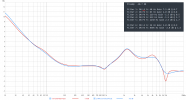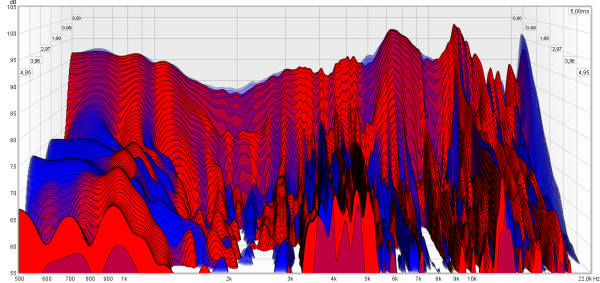johny_2000
Addicted to Fun and Learning
I don't know. I have never owned Monolith headphones.and the Monolith headphones How are they assembled?
I don't know. I have never owned Monolith headphones.and the Monolith headphones How are they assembled?
Are there any reasons to buy Sundara now?
They've lowered the price over the years (2017-2024) and now cost $299 new / $199 refurb.
But from a technical driver configuration perspective, they seem outdated to me compared to more recent planar headphones.
Thank you! So far I've listened to the FiiO FT5 and Moondrop Para planar headphones, which seem to be later models than the Sundara.You should really listen to them and the planar's you're interested in and see what you like. How headphones fit and feel is important too.
I have the sundara, the dca aeon 2 noire, DT 770 Pro (250R), and sony 1000xm5 (noise cancelling for travel). So, I have an open-back, closed-back, and noise cancelling. Plus the DT770 are some utility cans for use other places than my desktop.Thank you! So far I've listened to the FiiO FT5 and Moondrop Para planar headphones, which seem to be later models than the Sundara.
The FiiO had a comfortable fit and a self-adjusting suspension headband. Compared to the Moondrop which had a terrible fit. Unfortunately, both had quality issues. That's why I returned them.
That preset appears to peak at 0.5dB gain, which can cause digital clipping:Bought the Sundara (2022) some time ago and I'm using it with a Qudelix 5K with PEQ (balanced Tripowin cable) in connection with USB Audio Player Pro on an Android phone.
Very happy with this set up, though I sometimes have the feeling it sounds a tiny, tiny bit "artificial".
I have tried many PEQ settings an found this one to be the most pleasing to my ears.
Preamp: -11.0 dB Filter
1: ON LSQ Fc 28 Hz Gain 6.00 dB Q 0.71 Filter
2: ON PK Fc 66 Hz Gain -0.80 dB Q 1.50 Filter
3: ON LSQ Fc 105 Hz Gain 5.50 dB Q 0.71 Filter
4: ON PK Fc 940 Hz Gain -1.0 dB Q 3.70 Filter
5: ON PK Fc 2250 Hz Gain 3.30 dB Q 1.40 Filter
6: ON PK Fc 6105 Hz Gain 2.2 dB Q 1.50 Filter
7: ON PK Fc 10000 Hz Gain -3.0 dB Q 4.00 Filter
8: ON HSQ Fc 10000 Hz Gain -1.0 dB Q 0.71

Somewhat tricky do so, since the RME has quite complicated PEQ constraints, which you can read on page 14+15 here: https://rme-audio.de/downloads/adi2remote_e.pdfI will have now the opportunity to get a used RME ADI-2 DAC FS (AK4493) and was wondering how to convert the above 8-band setting to the 5-band PEQ of the RME ADI-2.

Somewhat tricky do so, since the RME has quite complicated PEQ constraints, which you can read on page 14+15 here: https://rme-audio.de/downloads/adi2remote_e.pdf
Band 1&5 can be PK, HS, or LSTricky? Is it because the bands 2, 3 and 4 seem to be set to peak and only on band 1 and 5 there are selectable filter types?
Now I get it, I didn't read the manual carefully enough.All of this complicates the PEQ design, compared to more conventional PEQs where you can do whatever you want with each band.
Was wondering what settings you use for the Sundara... Would you mind sharing them?I use EQ on my RME ADI-2 Pro or in SoundSource for the sundara and aeon2 noire (I'd EQ the DT770 too if I used them there). Nothing major, but it is better sounding to me.
There's a new kid on the block: Topping D50IIIBut there are not many other options for a DAC with PEQ beside the Qudelix 5K and the RME ADI-2...
Here's my take on it:Hi guys, first time posting. I am an audio professional, have a Neumann setup (with the DSP subwoofer) connected digitally to a Fireface and ADI-2 and linearized in phase in a well treated room (guess where a lot of my investment over the years producing went...).
I also own a Sundara (and a bunch of other headphones) since before we had our studio (I was renting a space that wasn't ideal, but had one "ideal" room). Over the past years the comparison I always did was Sundara with Sienna (Acustica's correction always felt good) versus whichever room I was in, and there was always a phase in production in which I switched between monitors and headphones, closer to the end.
With my room, I noticed I am not really "gaining" that much in perspective since my monitoring setup is pretty good, with the exception of removing a couple potential SBIRs from my desk and other things that happen in a room. So I am left browing incessantly, before I deliver the next recordings. Here are my ramblings:
1) I noticed Amir's correction is definitely in the right direction, although I tweaked it a touch in RME's TotalMix, and that seems to be a step forward from Acustica's correction, so that is an improvement;
2) What would be the next step up (without going to €1k or more range, because I would buy mixing/mastering hardware instead...) to the Sundara in terms of resolution and distortion, that gets as close as it gets to the Harman target with 3 (THREE) Eq points?
*** The Eq constraint, and this is coming from a work perspective, is because the more notches and the closer together they are, phase shifts and all, the higher the chance that I will actually hear the filter (because that's my job...) and be thrown off course. And this is also why I hate Sonarworks, I can hear its phase smearing and shifting and it's horrible, plus its targets are definitely wack.
Thank you for your reply, it definitely makes sense!Here's my take on it:
When Sundara works for you (comfortable and know its limits and EQ them anyway) I see no need to use other headphones. Just make sure you have some spare pads lying around as pad wear changes tonality.
On EQ... 3 band EQ is all that is needed. There is no need (nor advisable) to use more bands to EQ with 'more precision' to someone's measurement of a copy of said headphone on a certain fixture under certain test conditions. The EQ derived from that will ONLY be exact on that fixture, with that particular mounting(s) and I can guarantee you that test fixtures differ from your ears.
So... A Sundara needs to be compensated in the lows to get them to conform to Harman target (but also to taste/your tonal balance in your studio).
The upper midrange dip has to be compensated... again, this is partly personal so here too one can use a 'starting point' and adjust to your hearing/monitors.
Then you need to lower the treble peak (which they have but are in an area where standard test fixtures have a dip and your ears may have this at another frequency and that's all one needs for most hifiman headphones.






Wow, thank you for that!!!'speed' is in the upper midrange of the frequency response and all headphones (when EQ'ed to the same target) will be able to sound pretty similar.
Chances are the EQ for the Audeze and EQ for the Hifiman may have not ended up as envisioned by the applied EQ leaving the Audeze with an apparent 'faster' sound.
Both headphones are capable of reaching 20kHz so have enough 'speed'.
That said, the Audeze have much better damped membranes where the hifiman usually have poor damping above the upper midrange.
When resonances do not lead to peaks (or dips) but only show themselves in ringing length that might well be audible with some recordings/instruments.
Sundara waterfall:

Audeze LCD2(Fazor):

Ringing in the hifiman is notoriously poor/bad for all models.
Below the Edition XS:

The uber expensive Susvara is one of the better damped hifiman but rings a lot around 4kHz:

Below the (dynamic) HD490Pro:

And the Avantone Pro Planar (which is tonally not the best but reacts well to EQ) but is also heavy (560 gram):



Re: Sundara distortion: I have really enjoyed my DCA planars because of their tight, full, realistic bass. However, although my Sundara has significantly higher bass distortion, i often find it subjectively euphonic. For example, when I get in the mood for something with blues guitar, I will often listen with the Sundara, because of audible resonance that can give a bass guitar a little extra growl (depending on the instruments and the music). And so forth. As I think others may have mentioned, the Sundara is also tolerant of bass EQ to get closer to Harman, and I have other phones that are not so tolerant.'speed' is in the upper midrange of the frequency response and all headphones (when EQ'ed to the same target) will be able to sound pretty similar.
Chances are the EQ for the Audeze and EQ for the Hifiman may have not ended up as envisioned by the applied EQ leaving the Audeze with an apparent 'faster' sound.
Both headphones are capable of reaching 20kHz so have enough 'speed'.
That said, the Audeze have much better damped membranes where the hifiman usually have poor damping above the upper midrange.
When resonances do not lead to peaks (or dips) but only show themselves in ringing length that might well be audible with some recordings/instruments.
Sundara waterfall:

Audeze LCD2(Fazor):

Ringing in the hifiman is notoriously poor/bad for all models.
Below the Edition XS:

The uber expensive Susvara is one of the better damped hifiman but rings a lot around 4kHz:

Below the (dynamic) HD490Pro:

And the Avantone Pro Planar (which is tonally not the best but reacts well to EQ) but is also heavy (560 gram):

I recall the budget HE-4XX having cleaner CSD measurements than most other Hifiman headphones thoughWow, thank you for that!!!
That rings a lot of bells (no pun intended!). The few times I was sure I had finished something, only to go into a spur of last minute wrong interventions, were caused by a while of listening with the Sundara and focusing on high-mid vocal harshness on females and especially Male de-essing (happens often around 6-7kHz).
Probably also that's my perception of speed, if things "linger", then the space between two events gets drowned out while making judging levels much harder, that definitely would explain the crisper highs on the Audeze.
Knowing that while referencing, and doing frequent A/B listens over my monitors has already improved my day's work, those graphs are invaluable. Good vibes your way, good sir!
Also, would the Dan Clark Aeon be something free of that nasty ringing?
